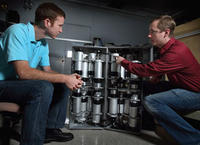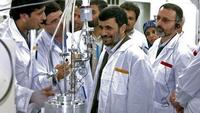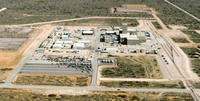-
Nuclear forensics to the aid of nuclear detectives
Fans of the popular TV series “CSI” know that the forensics experts who investigate crime scenes are looking for answers to three key questions: “Who did it; how did they do it; and can we stop them from doing it again?” The field of nuclear forensics has similar goals and uses similar techniques — but with even higher stakes. “In nuclear forensics, we want to know first, is someone able to put together the parts to make a nuclear weapon and set it off?” says one researcher. “And second, if one is set off, can we find out who did it, how they did it and are they going to do it again? Like traditional forensics, we’re looking for nuclear signatures, just like fingerprints; we’re looking for the technological and material clues and evidence to tell us what somebody had done to make this unfortunate thing happen.”
-
-
Realistic radiation detection training without using radioactive materials
Training of first responders on the hazards of actual radiological and nuclear threats has been challenged by the difficulties of adequately representing those threats. Training against such threats would involve using hazardous, highly radioactive materials, experiencing actual radiation doses in training, or require the distribution of radioactive material over a large geographical area. To avoid these issues in exercises to train responders, surrogate radioactive materials have been used, but these materials do not completely represent real threats due to their non-hazardous size and inability to be geographically distributed. Researchers have solved the problem by developing a new technology that provides realistic radiation detection training by directly injecting simulated radiation signals into the analog amplifier of the real detectors used by first responders and inspectors.
-
-
Sandia Lab’s mobile neutron imager shines in urban emergency response exercise

A nuclear device has been hidden in a high-rise building in a major metropolitan area. Emergency responders have intelligence that narrows down the location to a single city block, but it is not safe to search door-to-door. Can they identify the exact location of the device quickly without the culprits realizing a search is on? The answer is a definite yes. Sandia Lab’ mobile imager of neutrons for emergency responders (MINER) system did just that at an emergency response exercise in downtown Chicago earlier this year. The exercise used a sealed laboratory radiation source that mimics the radioactive signature of more nefarious material.
-
-
Transparent nanoscintillators for radiation detection in homeland security, medical safety
Researchers say recently identified radiation detection properties of a light-emitting nanostructure built in their lab could open doors for homeland security and medical advances. The researchers describe a new method to fabricate transparent nanoscintillators by heating nanoparticles composed of lanthanum, yttrium and oxygen until a transparent ceramic is formed. A scintillator refers to a material that glows in response to radiation.
-
-
New device improves radiation detection
In a move that could have important implications for national security, researchers have created a very sensitive and tiny detector that is capable of detecting radiation from various sources at room temperature. The detector is eight to nine orders of magnitude —100 million to as high as 1 billion — times faster than the existing technology. The researchers sought to utilize the exceptional electronic carrier properties of graphene to create the photo detector device. Graphene is made of carbon atoms that are arranged in a honeycomb-like geometrical structure (the diameter of a human hair is 300,000 times thicker than a two-dimensional sheet of graphene).
-
-
No Fukushima radiation found in California’s coastal areas
Following the 11 March 2011 Fukushima disaster, researches wanted to see whether radioactivity could be found in Bay Area precipitation. They collected weeks’ worth of rainwater around UC Berkeley Campus to find out. The results: low levels of a number of different radioactive nuclei produced by the fission of uranium-235 including, cesium-134, cesium-137, and iodine-131. “The levels we saw were detectable, but low and not a health hazard to anyone,” said UC Berkeley’s nuclear engineering professor Eric Norman.
-
-
Scientists improve accuracy, reliability of nuclear tests inspection
The Comprehensive Nuclear-Test-Ban Treaty Organization (CTBTO) operates the International Monitoring System (IMS) — 279 sensors-equipped facilities around the world which detect four types of physical phenomena that can provide evidence of a nuclear explosion having taken place: seismic waves, radioactive nuclei, underwater sound waves, and infrasonic waves. The evidence from the IMS is not always enough to convince signatories of the CTBT that a nuclear test has taken place. Scientists are trying to improve the accuracy and reliability of the IMS system.
-
-
Iran wants to expand its uranium enrichment capacity

Iran’s Supreme Leader Ayatollah Ali Khamenei said on Tuesday that Iran would need significantly to increase its uranium enrichment capacity for future energy needs, dealing a setback to negotiations between the country and world powers.
-
-
Game of marbles inspires nuclear-inspection protocol

Modern cryptography combined with simple radiation detectors could allow nuclear-weapons checks to be carried out with almost complete security. That is the conclusion of scientists in the United States, who have used computer simulations to show how a beam of neutrons can establish the authenticity of a nuclear warhead without revealing any information about that weapon’s composition or design.
-
-
Engineering nuclear nonproliferation

University of Virginia engineering professor Houston Wood’s career demonstrates the important role that engineers can play in making the world a safer place. For more than two decades, Wood has helped governments determine whether nuclear programs in other parts of the world are being dedicated to peaceful or military purposes. In recent years, Wood has been working to determine the break-out time that Iran would require to develop a nuclear weapon if it stopped allowing the International Atomic Energy Agency IAEA) to inspect its nuclear facilities.
-
-
WIPP radiation leak investigation focuses on Los Alamos National Laboratory (LANL)
The U.S. Department of Energy’s (DOE) accident investigation team reviewing the leak at the Waste Isolation Pilot Plant (WIPP) in Carlsbad, New Mexico has turned its focus to the Los Alamos National Laboratory (LANL). Communications between LANL and EnergySolutions, the contractor which packaged LANL’s waste for shipment to WIPP, have revealed that EnergySolutions switched from using an inorganic clay-based absorbent in the storage drums to an organic wheat-based mixture. Scientists are now trying to determine whether the switch to the organic substance is to blame for the chemical reaction that led to the explosion.
-
-
A farewell to (nuclear) arms: A novel technique could facilitate nuclear disarmament
A proven system for verifying that apparent nuclear weapons slated to be dismantled contained true warheads could provide a key step toward the further reduction of nuclear arms. The system would achieve this verification while safeguarding classified information that could lead to nuclear proliferation. Their novel approach, called a “zero-knowledge protocol,” would verify the presence of warheads without collecting any classified information at all.
-
-
Urgent need: Dirty bomb detection technology which does not rely on helium
It has taken 4.7 billion years for Earth to accumulate our helium reserves, but these reserves are dwindling at an alarming rate, and will be exhausted by around 2025. The supplies we have originated in the very slow radioactive alpha decay that occurs in rocks, and there is no chemical way to manufacture helium. The Department of Defense and other agencies use Helium-3 (He-3) to detect neutrons emanating from Special Nuclear Material (SNM) in order to counter the threat of nuclear-fueled explosives such as dirty bombs. Since the supply of He-3 is rapidly drying up, the Defense Threat Reduction Agency (DTRA) awarded a $2.8 million contract to Alion Science and Technology to develop a replacement technology which will detect neutrons without relying on He-3.
-
-
New Mexico demands clarifications, reassurances on WIPP radiation leaks

New Mexico’s environment secretary Ryan Flynn has ordered the Department of Energy (DOE) to explain how it will protect public health and the environment while it investigates a radiation leak at the underground Waste Isolation Pilot Plant (WIPP). The plant has not been in compliance with various permit requirements since the February underground fire and radiation leak, which eventually led to a plant shutdown.
-
-
Absorbent used in kitty litter may be cause of radiation leaks in U.S. nuke dump
A wheat-based absorbent often used in kitty litter may be the likely cause of the radiation leak that led to the closure of the Waste Isolation Pilot Plant(WIPP), the U.S. only underground nuclear waste repository, according to Jim Conca, a former geochemist at Los Alamos National Laboratory(LANL). Conca noted that EnergySolutions, a Salt Lake City-based company hired to package radioactive waste at LANL into containers for shipment to the WIPP, switched from using a clay-based absorbent in the storage drums to a wheat-based mixture.
-
- All
- Regional
- Water
- Biometrics
- Borders/Immig
- Business
- Cybersecurity
- Detection
- Disasters
- Government
- Infrastructure
- International
- Public health
- Public Safety
- Communication interoperabillity
- Emergency services
- Emergency medical services
- Fire
- First response
- IEDs
- Law Enforcement
- Law Enforcement Technology
- Military technology
- Nonlethal weapons
- Nuclear weapons
- Personal protection equipment
- Police
- Notification /alert systems
- Situational awareness
- Weapons systems
- Sci-Tech
- Sector Reports
- Surveillance
- Transportation
Advertising & Marketing: advertise@newswirepubs.com
Editorial: editor@newswirepubs.com
General: info@newswirepubs.com
2010-2011 © News Wire Publications, LLC News Wire Publications, LLC
220 Old Country Road | Suite 200 | Mineola | New York | 11501
Permissions and Policies
Editorial: editor@newswirepubs.com
General: info@newswirepubs.com
2010-2011 © News Wire Publications, LLC News Wire Publications, LLC
220 Old Country Road | Suite 200 | Mineola | New York | 11501
Permissions and Policies
